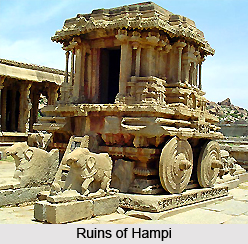 Rama Deva Raya was also referred to as Vira Rama Raya and reigned over the region of Vijayanagara from 1617to 1632 CE. During the year 1614, one of his relatives named Jagga Raya had brutally assassinated the father Sriranga II, along with his entire family. Rama Raya was able to escape from imprisonment with the assistance of Yachamanedu who was a loyal commander and viceroy of Venkata II.
Rama Deva Raya was also referred to as Vira Rama Raya and reigned over the region of Vijayanagara from 1617to 1632 CE. During the year 1614, one of his relatives named Jagga Raya had brutally assassinated the father Sriranga II, along with his entire family. Rama Raya was able to escape from imprisonment with the assistance of Yachamanedu who was a loyal commander and viceroy of Venkata II.
Jagga Raya had demanded that a son belonging to one of the queens of Venkata II must ascent the throne. However, Yachamanedu protested against this claim and instead declared that Rama Deva Raya would be the rightful heir to the throne of the Vijayanagar Empire. A fierce battle then occurred between Yachamendu and Jagga Raya. Finally, Jagga Raya was slain and Yachamanedu occupied the Gobburi estates which were located in the western part of Nellore and belonged to Jagga Raya.
Battles Fought by Rama Deva Raya
Jagga Raya who suffered defeat against Yachamanedu, again attacked Rama Deva Raya and Yachamanedu, after he was being aided by the Nayaks of Madurai and Ginjee. The Nayaks of Tanjore then countered the blow of Jagga Raya, and cooperated with the combine of Rama Raya and Yachamanedu in their defence against Jagga Raya.
At Tiruchirapalli, Jagga Raya, along with his allies namely the chieftains of Madurai, Portuguese belonging to the coastal regions, Chera king, and the Nayaks of Ginjee and Madurai arranged a gigantic army. Yachamanedu ordered his troops to march from Vellore and he was joined by the armies of the Nayaks of Tanjore which were led by Raghunatha Nayaka, the Tanjore ruler on his way to the battlefield. The combined armies were yet again joined by several nobles from the state of Karnataka, as well as some Jaffna and Dutch armies. During the year 1616, the soldiers of Jagga Raya and Yachamanedu met at Toppur, which was situated on the banks of Kaveri River, between Grand Anicut and Tiruchirapalli. This particular battle is believed to be one of the greatest wars which had occurred in southern India and due its vast quantity of armies, which amounted to over one million.
Jagga Raya was defeated since his armies were unable to bear the collective forces of all the royal armies on the side of Yachamanedu. In the battle, the armies headed by King Raghunatha and Yachamanedu were quite disciplined and it concluded by the slaying of Jagga Raya by Yachamanedu. Jagga Raya`s brother Yethiraja retreated in order to save his own life. It is said that Nayaka chieftain of Madurai made an attempt to flee the battlefield, however was captured close to Tiruchirapalli by Rao Dama Nayani, who was the general of Yachama. The Nayak of the region of Ginjee lost almost all his forts, while Ginjee Fort was the only exception. The son of Venkata II, who was the pivotal reason for all the political turmoil, was captured. Finally, Rama Deva Raya was crowned as the new king of Vijayanagara in the earlier part of the year 1617. He was hardly 15 years of age when he succeeded the throne.
After being defeated at the Toppur Battle, Yethiraja, Jagga Raya`s brother attacked Tanjore, being supported by the Nayak of Ginjee. However, they lost the war and the Ginjee Nayak was taken prisoner by the army of Tanjore. Yethiraja continued his evil actions of waging wars, till he finally entered into reconciliation with Rama Deva Raya when his daughter`s hand was offered in marriage, to the Rama Raya. After the death of the putative son of Venkata II in the year 1619, Rama Deva Raya`s rule was peaceful.
During 1620, the Bijapur Sultan attacked Kurnool and by 1624, he was capable of capturing Kurnool completely. Yachamanedu protested his marriage of Rama Deva Raya with the daughter of Yethiraja. He had advised the king not to enter into a matrimonial alliance with Yethiraja`s daughter but he ignored the suggestion. Humiliated, Yachamanedu tried to resign from the service to Rama Deva Raya on the pretext of old age. Thereafter, Yethiraja, who was now the father-in-law of Rama Deva Raya entered into open warfare with Yachamanedu, particularly after he had demanded the territories of Gobburi. By the year 1629, Yachamanedu`s armies were attacked by the army of Yethiraja, who as assisted by the forces of Ginjee and Tanjore. Though the armies of Yachamanedu was insufficient, they put up a bold resistance.
Finally, the Gobburi lands were submitted back to Yethiraja. The areas of Mathurantagam, Chengulpet and Pulicat were captured by Vellore. Yachamanedu was permitted to reign over Venkatagiri but he decided to spent the remaining part of his life under the protection of a chieftain known as Udaiyarpalaiyam. Since Rama Raya possessed no sons or brothers, he nominated Peda Venkata Raya or Venkata III, who was Aliya Rama Raya`s grandson to the throne. Rama Raya died in 1632, at the age of 30.



















